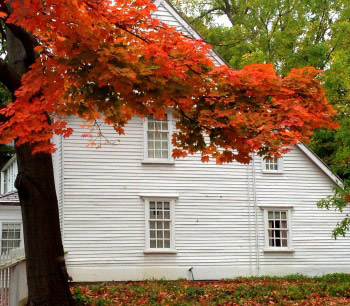Closer to Home
October 14, 2013 / Leaf-Peeping
One of the great joys of living in New England is the coming of the fall color change to the trees of our yards, roadsides and forests. Each year is different, but always beautiful.
The colors come from different processes, none of which involve Jack Frost with his little paint-pot. Instead, we have complex chemistry and physics to thank for our yearly autumn delights. What follows is the simple story—but as usual, go a little deeper and it is massively complicated. Read on anyhow.
Many leaves turn yellow. How does that work? You probably already know that trees and other green plants make their own “food,” a kind of sugar called glucose, and that they make it in a process called photosynthesis (from Greek words meaning “light” and “putting together”). The plants use a chemical called chlorophyll (from Greek meaning “green leaf”), which is green, plus water and carbon dioxide; these, in the presence of the energy of sunlight, produce the plants’ sugary nourishment. The chlorophyll in the leaves makes their green summer dress.
Well, in the fall, when the daylight time gets shorter and shorter, the trees gradually stop making new chlorophyll, since there’s less and less sunlight for it to work with. So slowly the tree or other plant leaves lose their green color.
That’s where the yellow and orange fall colors come in. Actually, those colors are present in the leaves all the time, all summer long. But the green color masks them, so when it begins to disappear, the bright yellow or orange pigments are revealed and glow forth in all their glory.
We’re all familiar with those yellow and orange pigments—in carrots, squash, sweet potatoes, tiger lilies, daffodils—and they are called xanthophyll or carotene: yellow and orange.
OK, what about the fabulous red leaves? Reds and purples come from a different process. At the same time that the plants stop making chlorophyll, they get ready for winter in another way. Just at the point where the leaf joins the twig, a special layer grows, called the abscission layer (from Latin meaning “to cut away”). The abscission layer shuts off the flow of water and sugar from the twig to the leaf. No point in sending this precious stuff to the leaf when it is just going to die! But some sugar is left trapped in the leaves. If nights are cool and days are sunny, this leftover sugar will develop into a red pigment, called anthocyanin.
The more acidic the trees’ sap, the redder their fall leaves will be. If the sap is more toward the alkaline, leaves will go maroon or pink.
We see that same red or purple color in beets, radishes, morning glories and hyacinths.
Some leaves turn brown instead of brighter colors. This is because of yet another process, oxidation, in which cells die (like a slice of apple left out in the air). The brown seems to be the color of dead cell walls. Oaks turn especially rich shades of brown.
This is the time of year when the buses carrying loads of leaf-peepers pour into New England. Everybody wants to see the color, wants to capture it with their phones and cameras. Every tour company should have all its leaf-peeping tours full, or know they are in trouble.

However, the leaves do not always cooperate. Depending both on the summer’s weather and the weather of the past few days, color will be brilliant or not. When I used to be a tour director, I would have to finesse the scene for my passengers. Sometimes there was not much to see, only a few leaves here and there. I would explain to the folks how if you take a closeup picture of the only two colored leaves in sight, the people back home would never know the whole rest of the forest wasn’t brilliant.
Or, if the color was there but not especially brilliant, I would use phrases such as “the marvelous subtle colors!” And then there would be the twig tour, the last one of the season. “Oh!” I would exclaim with [genuine] delight. “Look! You can see Mount Washington through the forest! You can’t see it if all those pesky leaves are still on the tree!”
People will see what they are directed to see. The trick is to keep the whole mind open to sights, and then you find glories everywhere. How about going outside right now and making a leaf rainbow?